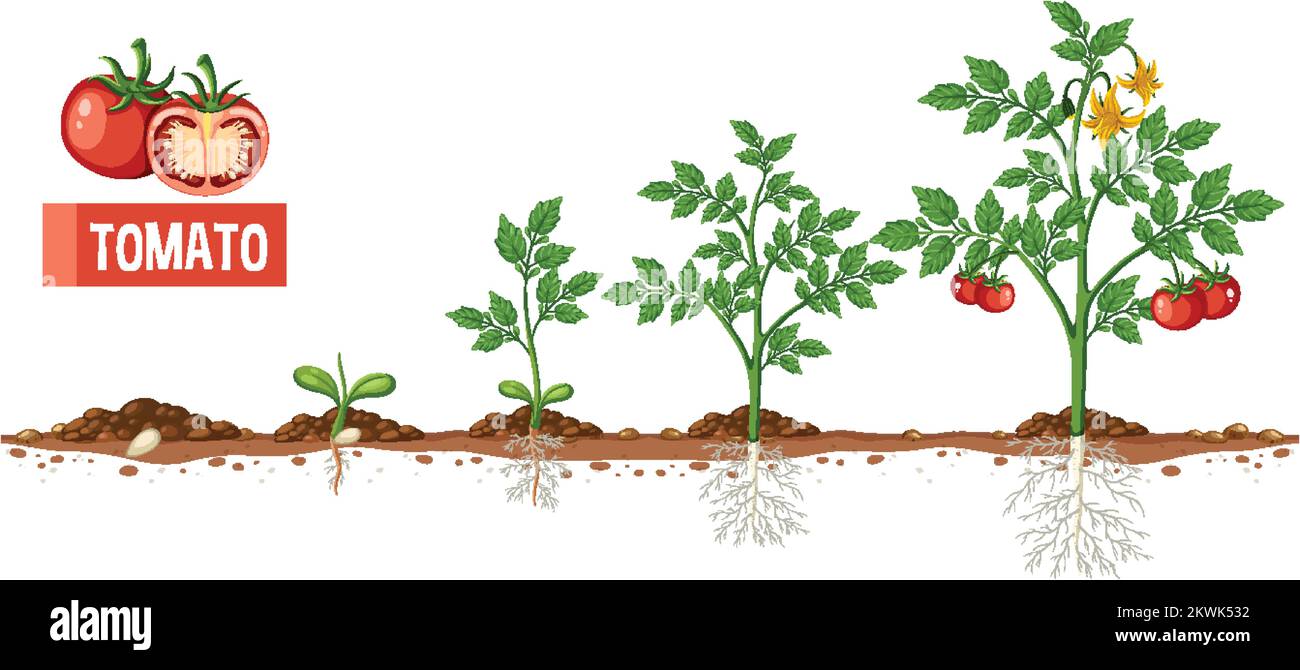With their juicy red fruits and bursts of summer flavor, tomato plants are a favorite for home gardens and commercial farms alike But what’s going on below the surface? Getting to know the different structures of a tomato plant can provide valuable insights into how to best grow these tasty crops. In this article, we’ll explore tomato plant anatomy with the help of informative diagrams
The Root System – Absorbing Vital Nutrients
Like all plants, tomatoes begin life as a seed with an embryonic root called a radicle. As the seed germinates, this root grows down into the soil, anchoring the developing seedling. Soon lateral roots branch off the main taproot, expanding the plant’s ability to take up water and nutrients.
The vast network of fine tomato roots typically extends 1-3 feet deep and up to 6 feet wide under ideal conditions Roots are covered in tiny root hairs that vastly increase the surface area for absorption Healthy roots are key for providing tomatoes with ample moisture, nutrients like nitrogen and phosphorus, and micronutrients such as zinc and magnesium.
Stems – Structural Support and Nutrient Transport
As the tomato plant matures, the stem provides essential support and facilitates nutrient distribution. The main tomato stem is composed of nodes (joints) and internodes (the regions between nodes). Leaves, flowers and fruits originate from the nodes.
Tomatoes are dicots, meaning the stems contain vascular tissue arranged in bundles. The xylem transports water and minerals from the roots up to the leaves and fruits. The phloem vessels distribute sugars and other compounds throughout the plant. This vascular system allows tomatoes to grow quite large and produce heavy fruit loads.
Leaves – Photosynthesis Factory
Tomato leaves are characterized by pinnate venation where the veins branch off a central midrib. The leaves serve a vital role in photosynthesis by harnessing sunlight to convert carbon dioxide and water into sugars. This produces energy the tomato plant needs for growth and fruit production.
Dense foliage provides good sun exposure for photosynthesis. However, overcrowded growth can promote disease. Judicious pruning improves air circulation and light penetration while removing aging leaves past their prime. Healthy green leaves drive fruit development.
Flowers – Where Pollination Occurs
Tomato plants produce yellow flowers containing both male and female reproductive parts. The stamen is the male structure, consisting of the anther at the tip which contains pollen grains. The female parts are collectively called the pistil, composed of the stigma, style, and ovary.
For pollination to occur, pollen must transfer from the anther to the sticky stigma. This is primarily achieved via bees and other insect pollinators vibrating tomato blooms to release pollen, aka “buzz pollination”. Once pollen reaches the stigma, the pollen tube grows down the style into the ovary to fertilize the ovules, resulting in seed development.
Fruits – Juicy Bites of Tomato Goodness
The fruits we enjoy are actually the swollen ovary walls that surround the developing seeds. Tomatoes are botanically classified as berries. Each fruit contains gelatinous pericarp walls, colloquially known as the “tomato jelly” that encloses the seeds and vertical septa that divide tomato locules.
Ripe tomatoes come in diverse sizes, shapes, and colors depending on variety – from tiny currant types to massive beefsteak slicers. Wild tomatoes are small with very little flesh. After centuries of cultivation, most tomatoes boast abundant, succulent flesh with great eating quality.
Harnessing Tomato Plant Anatomy for Better Growing
Learning the unique structures that make up tomato anatomy provides insights into how each part functions and contributes to the whole plant. Armed with this knowledge, we can make better decisions for optimum tomato health, pollination success, and bountiful fruit yields in our gardens and farms. Paying attention to tomato plant parts is the first step for cultivating truly thriving plants.
How TO Draw tomato plants step by step/draw a plant/tomato plant drawing
FAQ
How do you layout tomato plants?
What is the structure of a tomato plant?
What are the 4 stages of a tomato plant?
What does a tomato plant look like when it starts?
What are the 3 stages of a tomato plant life cycle?
The tomato plant life cycle is divided into 3 stages: leaf, flower, and fruiting. First, the root develops, then the seed sprouts. Next, the first leaves grow. As the plant ages, it produces more mature leaves and blossom buds. Flowers appear on mature tomato plants, awaiting reproduction.
What is the life cycle of a tomato plant?
The tomato plant’s life cycle starts from seeds, and as the plant grows and matures, flowers develop. Sexual reproduction occurs, and after pollination and fertilization, tomatoes develop, which also contain seeds, allowing for the tomato life cycle to start again.
How many parts does a tomato flower have?
The tomato flower has four main parts: This part protects the bud before it opens. It is green and it is first visible when the bud forms. attaches a flower to the main plant. In tomato flowers, the petals are usually yellow. This is the male part of the flower. It usually has a long, slender at the top. The anther is covered with
- A Complete Guide to Caring for Yuki Cherry Blossom Shrub - January 23, 2025
- Identifying Red Hot Poker Seeds: What to Look For When Harvesting Torch Lily Pods - January 23, 2025
- A Complete Guide to Harvesting Evening Primrose Seeds - January 23, 2025

